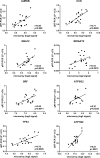Transcriptome profiles of hypothalamus and adrenal gland linked to haplotype related to coping behavior in pigs
- PMID: 31506580
- PMCID: PMC6736951
- DOI: 10.1038/s41598-019-49521-2
Transcriptome profiles of hypothalamus and adrenal gland linked to haplotype related to coping behavior in pigs
Abstract
The hypothalamic-pituitary-adrenal (HPA) axis is an important component of neuroendocrine stress regulation and coping behavior. Transcriptome profiles of the hypothalamus and adrenal gland were assessed to identify molecular pathways and candidate genes for coping behavior in pigs. Ten each of high- (HR) and low- (LR) reactive pigs (n = 20) were selected for expression profiling based haplotype information of a prominent QTL-region on SSC12 discovered in our previous genome-wide association study (GWAS) on coping behavior. Comparing the HR and LR pigs showed 692 differentially expressed genes (DEGs) in the adrenal gland and 853 DEGs in the hypothalamus, respectively. Interestingly, 47% (17 out of 36) of DEGs found in both tissues were located in GWAS regions identified on SSC12, indicating that there are significant functional positional candidate genes for coping behaviour. Pathway analysis assigned DEGs to glucocorticoid receptor signaling in the adrenal gland. Furthermore, oxidative phosphorylation, mitochondrial dysfunction, and NGF signaling as well as cholecystokinin/Gastrin-mediated were identified in the hypothalamus. We narrowed the list of candidate genes in GWAS regions by analyzing their DEGs in the HPA axis. The top identified transcripts, including ATP1B2, AURKB, MPDU1 and NDEL1 provide evidence for molecular correlates of coping behavior in GWAS regions.
Conflict of interest statement
The authors declare no competing interests.
Figures


Similar articles
-
Haplotypes of coping behavior associated QTL regions reveal distinct transcript profiles in amygdala and hippocampus.Behav Brain Res. 2019 Oct 17;372:112038. doi: 10.1016/j.bbr.2019.112038. Epub 2019 Jun 13. Behav Brain Res. 2019. PMID: 31202863
-
Unbiased multitissue transcriptomic analysis reveals complex neuroendocrine regulatory networks mediated by spinal cord injury-induced immunodeficiency.J Neuroinflammation. 2023 Sep 30;20(1):219. doi: 10.1186/s12974-023-02906-7. J Neuroinflammation. 2023. PMID: 37775760 Free PMC article.
-
Transcriptional signature of a hypersensitive glucocorticoid receptor variant in the neuroendocrine system suggests enhanced vulnerability to brain disorders.Brain Behav Immun. 2025 Feb;124:335-346. doi: 10.1016/j.bbi.2024.12.004. Epub 2024 Dec 12. Brain Behav Immun. 2025. PMID: 39674558
-
Circadian rhythms in the hypothalamo-pituitary-adrenal (HPA) axis.Mol Cell Endocrinol. 2012 Feb 5;349(1):20-9. doi: 10.1016/j.mce.2011.06.042. Epub 2011 Jul 18. Mol Cell Endocrinol. 2012. PMID: 21782883 Review.
-
Dissection of glucocorticoid receptor-mediated inhibition of the hypothalamic-pituitary-adrenal axis by gene targeting in mice.Front Neuroendocrinol. 2015 Jan;36:150-64. doi: 10.1016/j.yfrne.2014.09.002. Epub 2014 Sep 27. Front Neuroendocrinol. 2015. PMID: 25256348 Free PMC article. Review.
Cited by
-
Whole Transcriptome Analysis of Hypothalamus in Mice during Short-Term Starvation.Int J Mol Sci. 2023 Feb 6;24(4):3204. doi: 10.3390/ijms24043204. Int J Mol Sci. 2023. PMID: 36834616 Free PMC article.
-
Transcriptomic profiles of consistent risk-taking behaviour across time and contexts in European sea bass.Proc Biol Sci. 2022 May 25;289(1975):20220399. doi: 10.1098/rspb.2022.0399. Epub 2022 May 18. Proc Biol Sci. 2022. PMID: 35582798 Free PMC article.
-
The pink salmon genome: Uncovering the genomic consequences of a two-year life cycle.PLoS One. 2021 Dec 17;16(12):e0255752. doi: 10.1371/journal.pone.0255752. eCollection 2021. PLoS One. 2021. PMID: 34919547 Free PMC article.
-
Tissue-Specific Chromatin Accessibility Regions and Transcription Factor Binding Sites in Pig Brain and Endocrine Tissues.Mol Neurobiol. 2025 Jun 7. doi: 10.1007/s12035-025-05128-5. Online ahead of print. Mol Neurobiol. 2025. PMID: 40483385
-
Transcriptomic Changes of Photoperiodic Response in the Hypothalamus Were Identified in Ovariectomized and Estradiol-Treated Sheep.Front Mol Biosci. 2022 Apr 11;9:848144. doi: 10.3389/fmolb.2022.848144. eCollection 2022. Front Mol Biosci. 2022. PMID: 35480892 Free PMC article.
References
-
- Moberg, G. P. In The biology of animal stress: basic principles and implications for animal welfare Ch. 1, 1–21 (Wallingford, UK: CABI Publishing, 2000).
Publication types
MeSH terms
LinkOut - more resources
Full Text Sources
Miscellaneous

